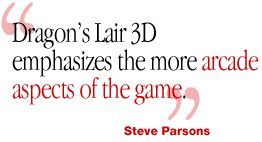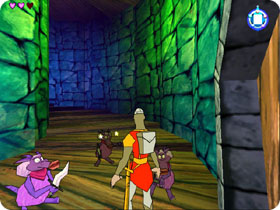
|
Page 1 | 2 |
There’s also an Unfair mode, but it’s really, really, well … unfair.

“Dragon’s Lair 3D emphasizes the more arcade aspects of the game,” explains Parsons. “This combines both a ‘twitch’ style evasion of danger, as well as combat with the creatures that live within the castle. Not only are there the typical characters to fight, but any part of the castle could be fatal: floors crumble away, books and chairs attack you, poison gas seeps in, and so forth.”
He continues: “The Classic mode was created to appeal to gamers who aren’t experts but want to play Dragon’s Lair 3D now. The Adventure mode is more for the Tomb Raider crowd. It allows the player to explore the entire castle during their quest to save the princess, and control every aspect of Dirk’s movement along the way.”
It’s All in Good Fun
Another aspect of the original game that has survived in the current version is the lack of bloody violence. When Dirk dies, he turns into a skeleton and crumbles, just like the animation in the original, and his enemies still glow violet when he kills them.
Explains Parsons: “We’re striving to create a game that uses ‘cartoony’ and not realistic violence. We’ve given it a name at the office: we call it ‘implied violence.’ We don’t need to show graphic violence to make a successful game; a game is about being fun and entertaining.”
This is part of the unique look and feel of the game, something that Parsons insists is very important.
“[This approach] makes the player fully aware of the unique game they are playing, and it will make the player feel that this game is truly the heir to the classic Dragon’s Lair,” he says.
He’s a Fan Too
If Parsons comes across as passionate about Dragon’s Lair, it’s because he’s as much of a fan of the game as many of the people he’s met during the development process.

Surrounded.
“I consider myself one of the original game’s addicted fans,” he says. “I once spent several weeks in England on a business assignment, and I spent more time playing Dragon’s Lair after work than I did touring London.
“The original was a brilliantly executed game for the technology available and the gameplay it possessed.”
Of Course It’s Built for Mac OS X
Parsons is also a fan of the Macintosh, and he confirms that the game will indeed play in Mac OS X.
“The Macintosh is becoming a strong alternative to the PC,” he says. “I think gaming on the Mac has a strong future and Dragonstone Software will maintain the expertise to develop on it.”
|
Dragon’s Lair was six years in the making when it debuted in arcades in 1983. Rick Dyer of Advanced Microcomputer Systems, Don Bluth of Bluth Studios, and a company called Cinematronics teamed up on the project. Bluth Studios created the 22 minutes of animation for the game. The budget was so tight that they couldn’t afford to employ voice actors, so studio employees played the roles themselves. The game was a hit in the arcades, grossing over $32 million in its first eight months and leading to a slew of merchandising that included toys, lunchboxes, and an animated Saturday morning TV show (produced by Ruby Spears, not Bluth Studios). There was even a feature film in the works, but the videogame industry entered a slump, the cartoon only lasted one season, and the game became a fond memory, although it was followed up by a little-seen sequel, Dragon’s Lair II: Time Warp, in 1991. Many faithful fans still remember pumping quarters into the game, however, and its memory lives on in the many web sites created around it. Some die-hards have even rescued old Dragon’s Lair machines and revamped them with better laserdisc players, working joysticks and buttons, and new cabinets so that they can own a piece of videogame history. Jeff Kinder’s Dragon’s Lair Project is one such site. He found a Dragon’s Lair game with severe water damage and rebuilt the cabinet. Like many fans, he’s looking forward to the release of Dragon’s Lair 3D.  “Once people see it,” he muses, “it will bring back the memories of playing the original. I’m sure a few of these people will set out to locate an original machine for their home and fulfill that childhood dream of owning an actual Dragon’s Lair arcade game.” “Once people see it,” he muses, “it will bring back the memories of playing the original. I’m sure a few of these people will set out to locate an original machine for their home and fulfill that childhood dream of owning an actual Dragon’s Lair arcade game.”If you’d like to play the original Dragon’s Lair on your Mac, take a look at Digital Leisure’s DVD version of the game, which works only in Mac OS X. The company also offers DVD versions of other laserdisc games of yesteryear, including Dragon's Lair II: Time Warp and Space Ace. |